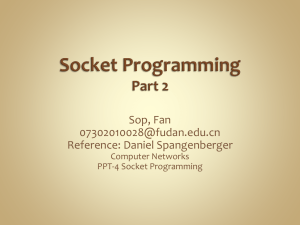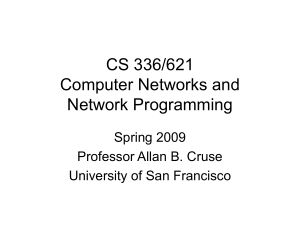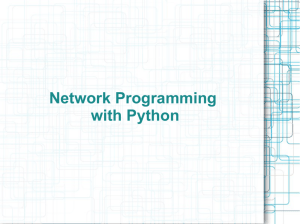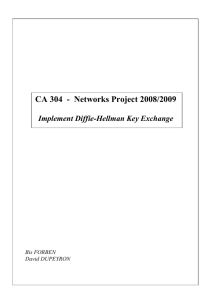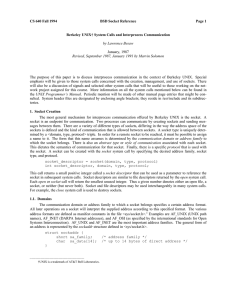Project - I Discussion An HTTP Request Tevfik Koşar
advertisement
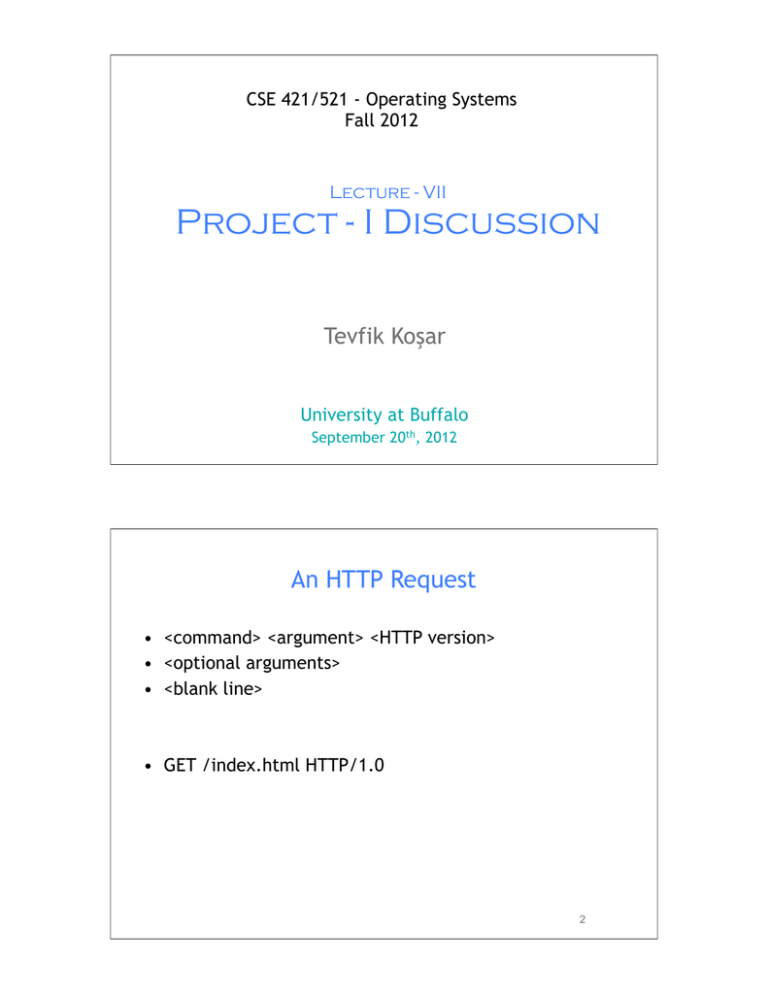
CSE 421/521 - Operating Systems
Fall 2012
Lecture - VII
Project - I Discussion
Tevfik Koşar
University at Buffalo
September 20th, 2012
1
An HTTP Request
• <command> <argument> <HTTP version>
• <optional arguments>
• <blank line>
• GET /index.html HTTP/1.0
2
Server Response
•
•
•
•
<HTTP version> <status code> <status message>
<additional information>
<a blank line>
<content>
•
HTTP/1.1 200 OK
Date: Thu, 06 Nov 2008 18:27:13 GMT
Server: Apache
Content-length: ......
<HTML><HEAD><BODY> ....
3
Example
$ telnet www.cnn.com 80
Trying 64.236.90.21...
Connected to www.cnn.com.
Escape character is '^]'.
GET /index.html HTTP/1.0
HTTP/1.1 200 OK
Date: Thu, 06 Nov 2008 18:27:13 GMT
Server: Apache
Accept-Ranges: bytes
Cache-Control: max-age=60, private
Expires: Thu, 06 Nov 2008 18:28:14 GMT
Content-Type: text/html
Vary: Accept-Encoding,User-Agent
Connection: close
<!DOCTYPE HTML PUBLIC "-//W3C//DTD HTML 4.01 Transitional//EN""http://
www.w3.org/TR/html4/loose.dtd"><html lang="en"><head><title>CNN.com -4
Basics of a Server (Web, FTP ..etc)
1. Listen to a Network port
2. Interpret incoming messages (requests)
3. Serve requests
a. Read requested files
b. Send them over network
4. Run consistently in the background (daemon process)
5
Network Communication
http
Client
http
Server
6
• TCP Client-Server view
• Connection-oriented
socket connections
7
Sockets
– A Socket is comprised of:
• a 32-bit node address (IP address)
• a 16-bit port number (like 7, 21, 13242)
– Example: 192.168.31.52:1051
• The 192.168.31.52 host address is in “IPv4 dottedquad” format, and is a decimal representation of the hex
network address 0xc0a81f34
– First developed at UC-Berkeley in 1983, Berkeley Socket
API part of BSD 4.2
8
Server Side Socket Details
9
Client Side Socket Details
10
Simple Web Server
11
Logic of a Web Server
• 1. Setup the server
– socket, bind, listen
• 2. Accept a connection
– accept, fdopen
• 3. Read a request
– fread
• 4. Handle the request
– a. directory --> list it
– b. regular file --> cat the file
– c. not exist --> error message
• 5. Send a reply
– fwrite
12
1. Setup the Server
int init_socket(int portnum)
{
...
gethostname( hostname , 256 );
/* where am I ?
*/
hp = gethostbyname( hostname );
/* get info about host */
...
bzero( (void *)&saddr, sizeof(saddr) ); /* zero struct & fill host addr*/
bcopy( (void *)hp->h_addr, (void *)&saddr.sin_addr, hp->h_length);
saddr.sin_family = AF_INET ;
/* fill in socket type */
saddr.sin_port = htons(portnum);
/* fill in socket port */
sock_id = socket( AF_INET, SOCK_STREAM, 0 );
/* get a socket */
...
rv = setsockopt(sock_id, SOL_SOCKET, SO_REUSEADDR, &on, sizeof(on));
...! !
!
!
!
bind(sock_id, (struct sockaddr *) &saddr, sizeof(saddr));
...
!
!
listen(sock_id, 1) != 0 );
...
return sock_id;
!
}
13
int main(int ac, char *av[])
{
2. Accept Connections
!
!
...
sock = init_socket(portnum);
...
/* main loop here */
while(1){
!
/* take a call and buffer it */
!
fd
= accept( sock, NULL, NULL );
...
!
fpin = fdopen(fd, "r" );
!
fpout = fdopen(fd, "w" );
!
!
!
!
!
!
!
!
!
!
!
!
!
!
!
!
!
}
return 0;
/* never end */
!
!
!
!
!
3. Read Requests
/* read request */
fgets(request,BUFSIZ,fpin);
...
while( fgets(buf,BUFSIZ,fp) != NULL && strcmp(buf,"\r\n") != 0 ) ;
/* do what client asks */
process_rq(request, fpout);
...
fclose(fpin);
fclose(fpout);
}
14
void process_rq( char *rq, FILE *fp)
{
!
...
!
!
/* create a new process and return if not the child */
if ( fork() != 0 ) return;
!
if ( sscanf(rq, "%s%s", cmd, arg) != 2 ) return;
...
!
!
!
!
!
!
!
if ( strcmp(cmd,"GET") == 0 )
{
if ( not_exist( item ) )
!
do_404(item, fp );
else if ( isadir( item ) )
!
do_ls( item, fp );
else
!
do_cat( item, fp );
}
...
exit(0);
}
15
void do_cat(char *f, FILE *fpsock)
{
!
!
!
!
char!*extension = file_type(f);
char!*content = "text/plain";
FILE!*fpfile;
int! c;
!
!
!
!
!
!
if ( strcmp(extension,"html") == 0 )
!
content = "text/html";
else if ( strcmp(extension, "gif") == 0 )
!
content = "image/gif";
else if ( strcmp(extension, "jpeg") == 0 )
!
content = "image/jpeg";
!
!
!
fpfile = fopen( f , "r");
if ( fpfile != NULL )
{
!
!
!
!
!
!
}
!
!
!
!
!
}
4.b Cat File
fprintf(fpsock, "HTTP/1.0 200 OK\r\n");
fprintf(fpsock, "Content-type: %s\r\n", content );
fprintf(fpsock, "\r\n");
while( (c = getc(fpfile) ) != EOF )
!
putc(c, fpsock);
fclose(fpfile);
16
Acknowledgments
• Advanced Programming in the Unix Environment by R.
Stevens
• The C Programming Language by B. Kernighan and D.
Ritchie
• Understanding Unix/Linux Programming by B. Molay
• Lecture notes from B. Molay (Harvard), T. Kuo (UTAustin), G. Pierre (Vrije), M. Matthews (SC), B. Knicki
(WPI), M. Shacklette (UChicago), J. Kim (KAIST), A. Dix
(Hiraeth), and J. Schaumann (SIT).
17

